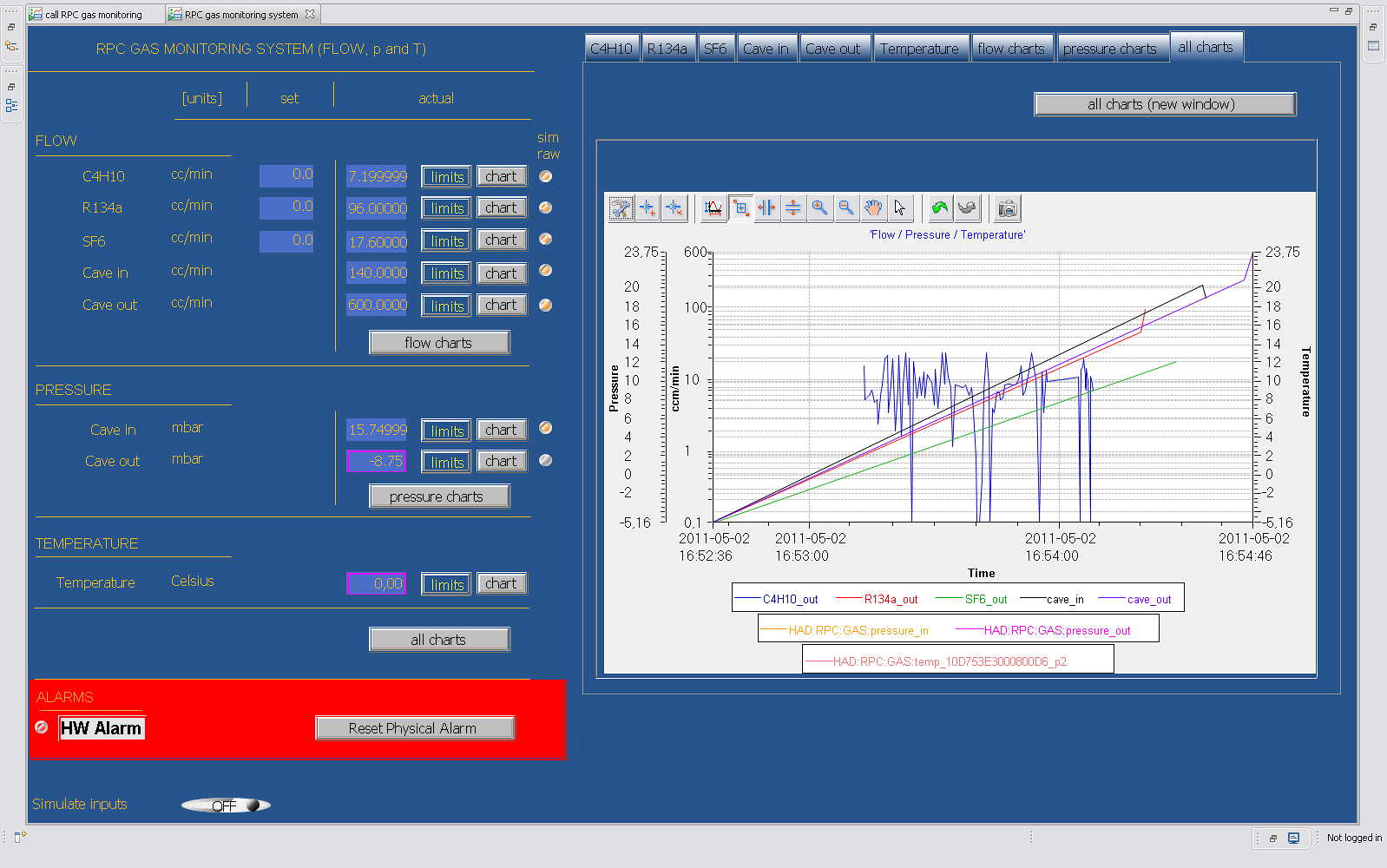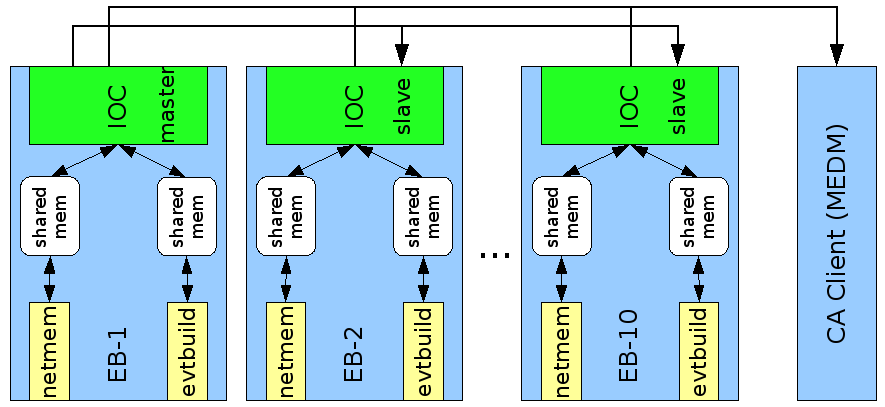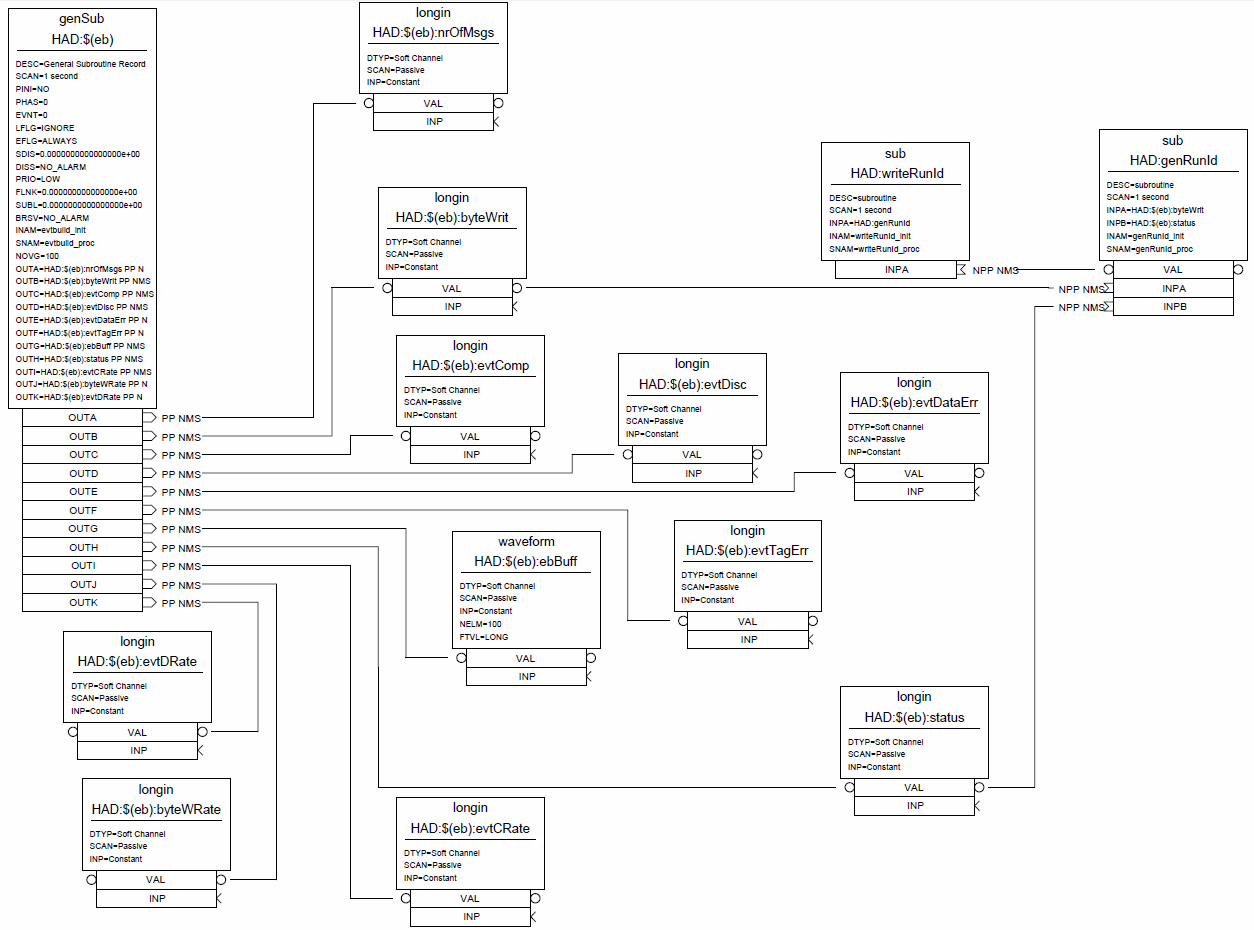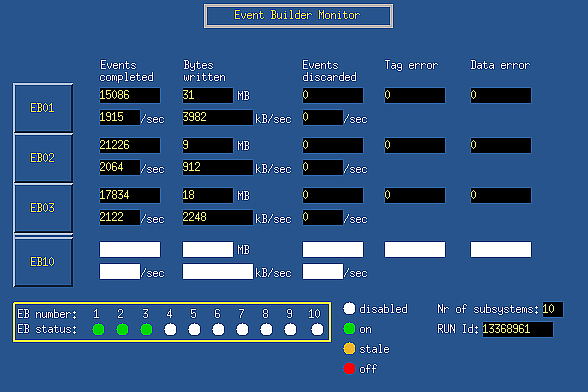You are here: GSI Wiki>Epics Web>EpicsProjectsAndActivities>ApplicationsGSI (2021-05-26, PeterZumbruch)Edit Attach

Applications
-
- HADES Magnet Control System - MCS
- Docker based EPICS IOC for ADC readout on Odroid / RPI to readout 4-20mA
- Docker based Caen DT1470 IOC Archiver GUI Setup
- HadCon2 General I/O Register Controls
- HadCon2 APFEL Controls
- HADES MDC CAEN1527 Network and Status Watchdog
- HADES MDC Gas Monitor
-
HADES RICH Current Monitor -
HADES RICH Gas Transmission Monitor - HADES RPC Threshold setting and Temperature/Voltage/Current Monitoring
- HADES RPC Gas System Monitor
- HADES Magnet Hall Sensor - Magnetic Field Monitor
- HADES DAQ Monitor
- HADES DAQ Event Builders
- trbnet 2 EPICS implementation (Documentation)
- EPICS trbnet Applicatons
- The objective is to modifiy the IO-Ports via EPICS Tools.
- Is meant as an generalized example application to be expanded or shrinked down to the end-user's needs
- code on github: https://github.com/zumbruch/HadCon2_AtmelRegisterIO_IOC
- The implementation of the APFEL specific procotol on HadCon2's AVR
- The implementation of an APFEL specific API command on HadCon2's AVR
- The implementation of the EPICS IOC able to access the HadCon2's APFEL API command
- The implementation of an CSS based GUI set to operate the APFEL
- optional: the preparation of a Raspberry Pi Image
- set and get via network as EPICS client the values of an extra measurement channel of the CAEN Crate (low Voltage)
- measures via an ADC ( HadCon2) the output voltage
- compares the results, settings, and the status
- in case of failures
- issue a "soft CPU reset" via the external, activated RESET input
- redo checks
- if still in case of failure:
- issue a RAMPDOWN cmd via the modified external "KILL" input of the special MDC CAEN1527LC version.
- wait the maximal rampdown time
- issue a "soft CPU reset"
- check output Voltage:
- . if still not Zero escalate Alarming
- remain in "safe shutdown"
- to monitor via EPICS
- the temperatures which are read out via single-wire bus protocol
- the voltage, representing the gas pressure
- to control and monitor via EPICS
- lower and upper threshold settings for the interlock for the HV supply, which reacts on the gas pressure.
- Collect status, documentation and requirements
- physical location
- available documentation
- scan rates
- Keep the ADC board, but replace the VME based CANbus controller by the HadCon2 and communicate via HadCon2's CAN commands with the existing ADC port
- replace the ADC board by
- (HADES Magnet)
- Hall sensor(s)
-
 Manual_F779.02.02-1.8.pdf: Manual of the Hall-Sensors
Manual_F779.02.02-1.8.pdf: Manual of the Hall-Sensors
-
- sensor line(s)
- 1-wire 16-bit Quad ADC(s) DS2450 (data sheet)
- The 1-wire ADCs are placed on a small separate PCB:
- HadCon
- HadCon API
- already existing EPICS database templates (already used by RPC Low Voltage controls)
- HADES HadCon startup script environment
- For this application 2 sensors are planned which feed separate 1-wire buses.
- - by methods of memory mapping -
provides information about the status, - AND
- by a master and slave mechanism -
provides an efficient method to synchronize and load balance up to 16 event builder cores each of it having up to 25 input streams. - trbnet
- documentation at http://jspc22.x-matter.uni-frankfurt.de/pub/trbnetdocumentation.pdf
-
libtrbnet:- CVS Root:
:ext:hadaq@lxi001:/misc/hadesprojects/daq/cvsroot - CVS Module:
trbsoft/libtrbnet
- CVS Root:
- aSub Records
- EPICS IOC
-
trbnet_ioc:- git:
- cvs
- CVS Root:
:ext:scs@lx-pool.gsi.de:/u/scs/cvs/repository/scs - CVS Module:
scs-linux/epics_apps/trbnet
- CVS Root:
-
- In order to connect to the MBS status port an IOC was programmed by Jörn Adamczewski.
- A medm user interface is available from Hans Essel.
HADES Magnet Control System - MCS
No permission to view HadesMcs ... more see Project Page for detailsStatus: ~50%
No permission to view Epics
Docker based EPICS IOC for ADC readout on Odroid / RPI to readout 4-20mA
%FOREACH{"project" in="DockerBasedIocAdcReadoutOf4To20mAonOdroidOrRaspi"}% $percntINCLUDE{"$project" section="abstract" plus="++"}$percnt ... more see Project Page for detailsStatus: development/configuration: finished, Testing by client/uer: 95%
$percntREVINFO{topic="$project" "-- $wikiusername - $date"}$percnt
%NEXT{"project"}%
Docker based Caen DT1470 IOC Archiver GUI Setup
%FOREACH{"project" in="DockerCaenDT1470IocArchiverGuiSetup"}% $percntINCLUDE{"$project" section="abstract" plus="++"}$percnt ... more see Project Page for detailsStatus: development/configuration: finished, Testing by client/uer: 95%
$percntREVINFO{topic="$project" "-- $wikiusername - $date"}$percnt
%NEXT{"project"}%
HadCon2 General I/O Register Controls
EPICS IOC based on StreamDevice to access HadCon2's Registers via the commandsRGRE and RGWR for read and write. Status: out of the drawer, already prepared project: 95%
-- PeterZumbruch - 2015-06-26
HadCon2 APFEL Controls
This projects objective is the control of the slow control parameters of an APFEL ASIC with the HadCon2 controller board, which itself could be connected to a computer (here a Raspberry Pi (1) Model B) running an EPICS IOC. The EPICS IOCs data are visualized using the Control System Studio CSS. Thus the project comprisesStatus: running system, deployed, documentation: 95%
-- PeterZumbruch - 2017-05-29
HADES MDC CAEN1527 Network and Status Watchdog
On Request of the HADES MDC group a local EPICS based watchdog unit is built toStatus: development: 30%
HADES MDC Gas Monitor
The large scale HADES Experiment at GSI uses drift chambers for particle tracking purposes. In order to monitor the gas pressure of the filling gas the MDC Gas Monitor NIM module has been developed. It serves primarily as an interlock for the high voltage in case the pressure is out of its working range. For the remote controlling and monitoring of the pressure, of the interlocks thresholds and of several temperatures of critical electronic components the general purpose board HADControl (aka HADSHOPOMO) is used. This board, designed and developed by the EE department of GSI (M.Traxler) is based on the ETRAX single chip computer by AXIS running Linux. This projects tasks is... more see Project Page for details
Status: running system, documentation: 80%
-- PeterZumbruch - 2011-02-25
HADES RICH Current Monitor
-
The large scale HADES Experiment at GSI uses a RICH (ring imaging cherenkov detector) for particle discrimination and (basic) tracking purposes.
In order to monitor the currents on the detection plane in each of the six sectors, an ADC board has been developed by the Munic RICH team.
It communicates via CANbus. Currently it is connected to a VME CPU via an IPAC carrier module. The VME CPU is running the EPICS IOC accessing the ADC board.
The projects objective is to gradually replace this system with a HadCon2 based Ansatz.
... more see Project Page for details
Status: stopped: 100%
-- PeterZumbruch - 2015-03-03
HADES RICH Gas Transmission Monitor
The large scale HADES Experiment at GSI uses a RICH (ring imaging cherenkov detector) for particle discrimination and (basic) tracking purposes.
In order to monitor the gas quality concering UV transmission, an ADC board has been developed by the Munic RICH team.
It communicates via CANbus. Currently it is connected to a VME CPU via an IPAC carrier module. The VME CPU is running the EPICS IOC accessing the ADC board.
The projects objective is to gradually replace this system with a HadCon2 based Ansatz. ... more see Project Page for details
Status: kickoff: 27 Jan 2015, documentation 5%
-- PeterZumbruch - 2011-07-19
r2 - 2015-02-04 - 10:14:11 - PeterZumbruch
HADES RPC Threshold setting and Temperature/Voltage/Current Monitoring
The large scale HADES Experiment at GSI upgrades the new RPC (resistive plate chamber) detector of HADES.The readout is based upon the TRBv2: General Purpose Trigger and Readout Board (
Therefore the RPC setup requires control and monitoring elements to set and read two threshold settings for each RPC channel.
In addition 1-Wire© bus based temperature sensors on DAQ boards have to be monitored.
These data are collected via the AXIS' ETRAX FS chip on the TRBv2 board responsible for the DAQ. Since EPICS can be run on ETRAX's cris architectures, EPICS will be used to provide this functionality.
As a further device the proposed Low Voltage Supply Board's temperature, voltages and currents have to be monitored via the ETRAX LX based HADcon(trol) general purpose board module (a.k.a. HADShoPoMo).
... more see Project page for details.
Status: currently developed
-- PeterZumbruch - 2011-02-24
HADES RPC Gas System Monitor
Besides the Threshold setting and Temperature/Voltage/Current Monitoring the RPC (resistive plate chamber) detector of HADES requires EPICS based monitoring of their gas system parameters.The data of the gas system are retrieved by a proprietary hardware controller controlling/monitoring flow (set/get), and (differential) pressure (get). It is accessible via CANbus. This CANbus is connected to a HADcon(trol) general purpose board, where an EPICS Server is running. This IOC collects the data provided by the HADcon's microcontroller via the streamDevice protocol and provides them to EPICS clients such as a CSS based BOY GUI build for this purpose.

... more see Project page for details.
Status: running remote setup (Coimbra), documentation: 110%, project finished, extended on request
-- PeterZumbruch - 2011-07-19
HADES Magnet Hall Sensor - Magnetic Field Monitor
Using the port folio of HadCon based applications the objective of this project is to realize a reading of several hall sensor values to be available inside HADES EPICS based control system. The major components are:... more see Project page for details.
Status:design started, documentation: 10%
-- PeterZumbruch - 2013-03-21
HADES DAQ Monitor
The HADES data acquisition system is based on the trbnet architecture. Its status and controls are accessed via the command (shell,library)trbnet.
Up to now its (ASCII) output is efficiently parsed by perl routines and displayed in an ASCII view or forwarded to gnu-plot. Those plots are dynamically created depending on the data return of trbnet and its dynamic configuration. In view of an integration of at least the monitoring features into the already used EPICS system at HADES this data flow should be extended/replaced.
Possible problems might occur due to missing features for dynamic behavior of the gui (maybe solved by JavaScript scripts, using BOY GUIs of CSS (SNS)), insufficient performance, and/or complex data structures to transport.
... more see Project page for details.
Status: first dummy implementation for playground, documentation: 50%
-- PeterZumbruch - 2018-01-08
HADES DAQ Event Builders
HADES data acquisition's event builders have dedicated IOCs which:

 The objective of this project is therefore to provide an additional documentation of the system and a collection of links to the existing documentation of the HADES collaboration's wiki.
The objective of this project is therefore to provide an additional documentation of the system and a collection of links to the existing documentation of the HADES collaboration's wiki.
... more see Project page for details.
Status: in principle a summary and collection of links for maintainance an existing system, documentation: 5%
-- PeterZumbruch - 2011-07-06
trbnet 2 EPICS implementation (Documentation)
EPICS trbnet Applicatons
trbnet to EPICS implementation using aSub records
Starting within the HADES project, an EPICS application for the readout of the CTU (central trigger unit) has been built by Burkhard Kolb. This EPICS IOC connects to the "trbnet command server" and, reads and writes array blocks of information, using the libtrbnet library into EPICS asub records.
In a second step, up-to-now: integrated, but to be disentangled in future, the CTU specific information is derived by breaking the information down into single units of information by properly decoding the basic information. When writing this information has to be combined before writing again to the trbnet.
The following elements are used and/or described:
-- PeterZumbruch - 2016-09-08
device support module
Florian Feldbauer, Andreas Neiser HIM/GSI, PANDA see code : at http://jspc29.x-matter.uni-frankfurt.de/git/?p=epics.git;a=tree;f=Trbnet/devTrbnet;h=67b63176b98932613015a6f003a0a0975e664714;hb=HEAD or download:git clone git://jspc29.x-matter.uni-frankfurt.de/projects/epics.git-
... wir hatten angefangen an einer Schnittstelle EPICS-trbnet zu arbeiten. Da aber in PANDA beschlossen wurde, dass das spaeter alles ueber SODAnet und nicht über EPICS laufen wird, und auch weil die Implementierung des Broadcast features vom trbnet eine sehr speicherlastige loesung erfordert haette, wurde diese Arbeit hier nicht weiter verfolgt... (FF 09/2016)
... more see Project page for details.
Status: , documentation: 10%
-- PeterZumbruch - 2020-11-09
FOPI mbsMonitor
MBS status IOC.... more on FOPI's usage of the MBS monitor
Status: running system
-- PeterZumbruch - 2007-09-14
-- PeterZumbruch - 06 Sep 2007
-- -- PeterZumbruch - 2020-08-05
-- PeterZumbruch - 2021-05-26
Edit | Attach | Print version | History: r19 < r18 < r17 < r16 | Backlinks | View wiki text | Edit wiki text | More topic actions
Topic revision: r19 - 2021-05-26, PeterZumbruch
- User Reference
- BeginnersStartHere
- EditingShorthand
- Macros
- MacrosQuickReference
- FormattedSearch
- QuerySearch
- DocumentGraphics
- SkinBrowser
- InstalledPlugins
- Admin Maintenance
- Reference Manual
- AdminToolsCategory
- InterWikis
- ManagingWebs
- SiteTools
- DefaultPreferences
- WebPreferences
- Categories
 Copyright © by the contributing authors. All material on this collaboration platform is the property of the contributing authors.
Copyright © by the contributing authors. All material on this collaboration platform is the property of the contributing authors. Ideas, requests, problems regarding GSI Wiki? Send feedback | Legal notice | Privacy Policy (german)
